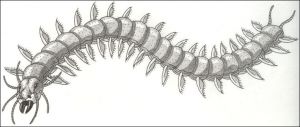The conrit or many-finned sea serpent is an unverified species or group of species of marine animals which seem to possess numerous fins along their sides or backs.
Description/Morphology
The creatures are supposedly capable of growing to enormous lengths; around 45 m for one such creature sighted near Algeria. In his book, On the Nature of Animals (second century CE), Greek military writer Aelian reported that these sea serpents were known to beach themselves. He also reported that witnesses had described such creatures as having lobster-like tails and large nostrils with hair.
Etymology
Zoologist Bernard Heuvelmans called this cryptid the "Many-finned" type in his general classification of sea serpents, and gave it the scientific name of Cetioscolopendra aeliana. In the sixteenth century, the creatures had been referred to as "cetacean centipedes" by Guillaume Rondelet. Even earlier, Aelian dubbed the animals the "Great Sea-Centipedes". Author Loren Coleman used nearly the same term (Great Sea Centipede) to describe these animals in his book The Field Guide to Lake Monsters, Sea Serpents, and other Mystery Denizens of the Deep. In Vietnam, such creatures are called "Con rit", which is Vietnamese for "centipede".
Sightings
In 1883, a dead specimen of an armored sea serpent was supposedly observed on a beach in Hongay, Along Bay, Vietnam. Witness Tran Van Con claimed that the carcass was 18 meters long, and was covered with 60-cm armored segments throughout its length. Attached to each segment was a pair of filament-like structures, each of them being 70 cm long. The body was dark brown above, and light yellow on its underside. The headless carcass was later towed out to sea. The alleged incident was reported 38 years after the fact to Dr. A. Krempf.
In 1899, the ship HMS Narcissus was traveling near Cape Falcon, Algeria, when the sailors aboard sighted a "sea monster". Estimated at 45 meters in length, the animal possessed an "immense number of fins", which propelled it through the water with enough speed to keep pace with the ship. The creature was observed for 30 minutes.
Theories about origin and existence
Bernard Heuvelmans theorized that such animals were armored whales, and pointed out that ancient whale fossils had been known to possess bony dermal plaques. However, such plaques present in association with whale fossils are now known to come from other species. Thus, there is no evidence that armored whales ever existed.
References
- Coleman, Loren and Huyghe, Patrick (2003). The Field Guide to Lake Monsters, Sea Serpents, and other Mystery Denizens of the Deep. NY: Tarcher-Penguin

